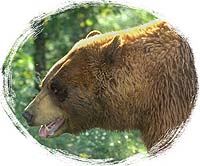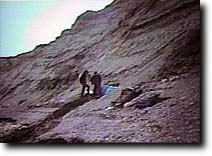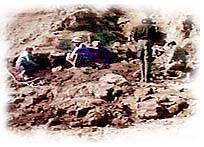
At Long Last
The fog that rolled in with the cold north wind off the ocean lasted all night. Maybe today we will get the bones we’ve been after for so long. We stayed at our campsite for the morning. After lunch, we will hike down to see if we can find some bones.
About 1:00, we hiked two miles to the bone site, being careful to avoid the quicksand Dan was stuck in last night. We certainly didn’t want to go through that ordeal again. When we came to a place that looked questionable, we sent one guy on ahead, to test out the mud. It was better for one guy to get stuck than all of us at once. The weather cleared up and the skies were partly to mostly sunny. I think my nose even got a little sunburned.

There were some very large grizzly tracks in amongst the willows on the way. They looked fresh. I’m surprised we haven’t seen a bear yet. Maybe (hopefully) when they hear us coming, they take off and avoid us.

At long last
With our GPS and direct coordinates, we easily found the Liscomb Bone Bed. There were scattered bits of bone in the rubble above the layers of the bed. After removal of the rubble, we found the bones were coming from two coal layers and a gray shale layer sandwiched between them. We were digging on a fairly steep slope 15 feet above the river. I could not believe how many bones were present! Most of the bones found were disarticulated (they were not lying next to each other in their original life positions). Because of this and the abundance of bones one is led to believe these are the bones from many animals, not just one or two who happened to die here. What kind of water catastrophe occurred to deposit all of these bones from all these animals? Noah’s Flood?

When vertebrate animals die, they are usually scavenged by other animals. Bacteria also play their role, and in a matter of years (or less) there are no remaining traces of the organism if it dies on land. By far, this would be the normal place for a land animal to die. For example, there were millions of buffalo that roamed the prairies of North America one hundred and fifty years ago. Where are all of their skeletons today? They have long since disappeared as the result of the decay process. If something doesn’t happen to the skeleton to prevent decay, it will never become fossilized. The dinosaur bones we are finding today appear to be the result of water deposition.
Dinosaurs were land animals. How did their abundant remains end up in water laid deposits? One hypothesis is that the dinosaurs drowned during Noah’s Flood. Their dead, decaying bodies then floated in the Flood waters. As decay progressed, parts of their bodies would fall to the sea bottom and be buried (preventing further decay) by the sedimentary processes of the Flood. This is a possible explanation for finding the usual occurrence of partial and disarticulated dinosaur skeletons in water laid deposits. The bones of the Liscomb Bone Bed appear to be consistent with this hypothesis.

The Liscomb bone bed has produced the most important dinosaur remains from Alaska. We collected bones on and below the surface. We found both fossilized and unfossilized bones. We dug down about three feet to get to the bones frozen in permafrost. It was the frozen unfossilized bones we were seeking for our research, although we collected some fossilized bones as well. Both types were found together (I’m not sure how to explain it). You can tell right away whether a bone is fossilized or not because of its weight. The fossilized bones have had minerals deposited within the pore spaces of the bone making it heavier.
Within two hours we had plenty of bones for our project. We were surprised at their abundance. I thought we may have needed several days to collect the bones for our project. The Lord sure has been good—He has provided everything we have found. All the struggles we have had so far have been worth it.
After collecting, we had a prayer of thanksgiving and praise for our wonderful Creator. We could not help but praise the Lord for his goodness to us. As I walked back to camp, I wondered how important were the bones I was carrying on my back? What would they contain? Could they help us answer some questions concerning the creation/evolution issue? Only time would tell.
It sure seemed like the enemy had done everything possible to discourage us from getting to them. We had been put through the fire with mosquitoes, hypothermia, quicksand and exhaustion. Dinner sure did taste good that night!
At 10PM I headed to bed once again rejoicing in the day’s events.



